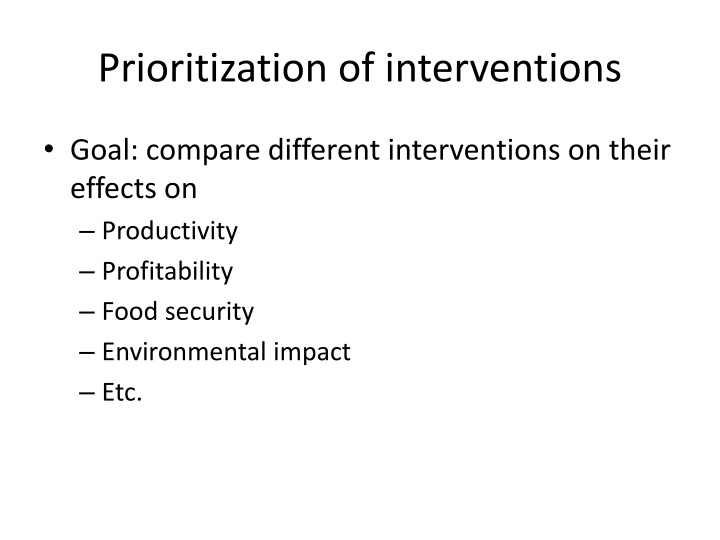
Innovative Prioritization Methods for Intervention Comparison
Discover various techniques for prioritizing interventions based on their impact on productivity, profitability, food security, and environmental aspects. Explore qualitative and quantitative approaches, including fuzzy cognitive mapping, linear programming, and more, to optimize outcomes and manage trade-offs effectively.
Uploaded on | 2 Views
Download Presentation

Please find below an Image/Link to download the presentation.
The content on the website is provided AS IS for your information and personal use only. It may not be sold, licensed, or shared on other websites without obtaining consent from the author. If you encounter any issues during the download, it is possible that the publisher has removed the file from their server.
You are allowed to download the files provided on this website for personal or commercial use, subject to the condition that they are used lawfully. All files are the property of their respective owners.
The content on the website is provided AS IS for your information and personal use only. It may not be sold, licensed, or shared on other websites without obtaining consent from the author.
E N D
Presentation Transcript
Prioritization of interventions Goal: compare different interventions on their effects on Productivity Profitability Food security Environmental impact Etc.
Prioritization of interventions Quantify or give ratings to consequences of interventions on indicators that can be used to calculate the objectives mentioned on the previous slide
Prioritization of interventions: Qualitative Fuzzy cognitive mapping Semi-quantitative / Qualitative maps of system functioning Relationships must be specified Qualitative consequences of interventions can be calculated through with these maps Powerful way to take into account uncertain and qualitative knowledge
Prioritization of interventions: Qualitative Murungweni et al., 2011; Ecology and Society
Prioritization of interventions: Quantitative Optimization of effect sizes through Linear programming (LP, or linear optimization) is a standard approach to do that LP is a mathematical method for determining a way to achieve the best outcome (such as maximum profit or lowest cost) in a given mathematical model for some list of requirements represented as linear relationships.
Prioritization of interventions How does it work? Baseline system performance should be quantified Per intervention an effect size should be quantified Objective(s) should be defined LP finds best linear combination maximizing the objective(s) Trade offs between different indicators can be quantified using MGLP
Prioritization of interventions Drawbacks: All effect sizes need to be quantified accurately LP results in single, best solutions
Prioritization of interventions Therefore: take into account UNCERTAINTY of effects of interventions on system performance indicators
Prioritization of interventions By sampling these uncertainty intervals you get packages of interventions, rather than single optimal solutions Insight in the robustness of the intervention you are proposing Insight in key factors that need more accurate quantification
Construct effect size table: based on literature values and expert knowledge Interventions Livestock Production (short term) Labour hours costs GHG emissions Short term Investment costs Current situation xxx xxx xxx xxx 1 + 10% (stdev 8) +20% (stdev 15) +10% (stdev 5) +30% (stdev 10) 2 + 20% (stdev 5) +40% (stdev 15) +20% (stdev 7) +50% (stdev 20) 3
Prioritization of interventions Very important: specify the units in which you express the indicators (for example: productivity, kg milk per head per year) So: variables/factors that can not be quantified are difficult to take into account
Indicator 1 Intervention 1 Indicator 2 Indicator 3 Model Intervention 1 Indicator 1 Intervention 2 Indicator 2 Indicator 3
Indicator 1 And this you do very often (e.g. 1000s of times) to know the probability of choosing certain interventions 1. under which conditions; 2. with which objectives. Intervention 1 Indicator 2 Indicator 3 Model Intervention 2 Indicator 1 Intervention 2 Indicator 2 Indicator 3
Thereby it is a simple and rough way of prioritizing Uncertainty / Variation in Climate Probabilities of decisions Prices Model Probabilities of indicator outcomes Farm characteristics Trade offs between indicators Model parameters
Further steps Here the model of the previous slide is a linear, static response model But this can be made more complex, and non- linear optimization can be used
